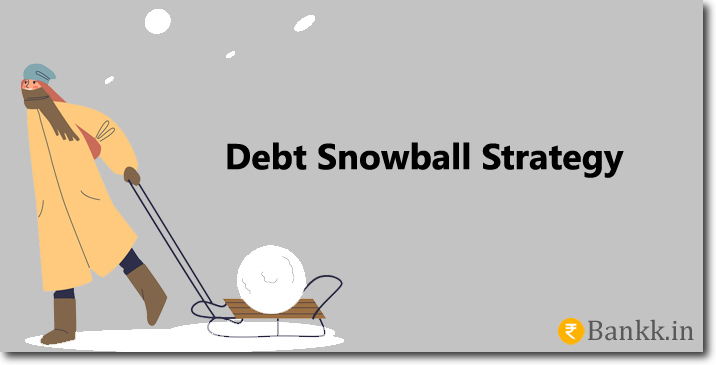Debt is a burden that can significantly impact an individual’s financial well-being. It can limit your financial freedom, cause stress, and this may even lead to serious mental health issues. It’s like a dark cloud that hangs over your life, casting a shadow on your dreams and aspirations.
However, it’s important to remember that debt is not a personal failure; it’s a financial situation many people find themselves in due to various circumstances. And just as there are ways to get into debt, there are strategies to get out.
One such powerful method is the Debt Snowball Strategy. It’s not just about the numbers; it’s about building momentum and staying motivated in your journey toward financial freedom.
What is the Debt Snowball Strategy?
The Debt Snowball Strategy is a debt repayment method that focuses on paying off the debts in order of smallest balance to the largest balance, regardless of interest rates.
This strategy differs from other methods like the Debt Avalanche Strategy, which prioritizes debts with the highest interest rates. The effectiveness of the Debt Snowball Strategy lies in its psychological and motivational aspects.
How the Debt Snowball Strategy Works?
The Debt Snowball Strategy is a systematic and disciplined approach to debt repayment. It’s a step-by-step process that requires consistency and commitment. Here’s how it works:
1. Make a list of all your debts from smallest to largest balance
The first step in the Debt Snowball Strategy is to take stock of all your debts. This includes credit card balances, personal, student, home, and car loans.
Organize these debts from smallest to largest balance. This gives you a clear picture of your debt situation and sets the stage for your repayment plan.
For example, if you have three debts of Rs. 5,000, Rs. 20,000, and Rs. 30,000, respectively, you would list them in this order.
2. Make the minimum payment on all your debts except the smallest one
The next step is to pay the minimum due on all the debts you have except the smallest one. This ensures you stay current on all your debts while focusing extra payments on the smallest debt.
For instance, if the minimum payment for your Rs. 5,000 debt is Rs. 1,000, and for the other two debts, it’s Rs. 2,000 each, you would pay these amounts towards each debt.
3. Allocate any extra funds to the smallest debt
Any surplus money you have goes towards paying off the smallest debt faster. This could be money from a part-time job, selling items, or cutting back on expenses.
If you have an extra Rs. 1,000, you will pay your Rs. 5,000 debt. This accelerates the repayment of the smallest debt and brings you closer to your first debt-free milestone.
4. Once the smallest debt is paid off, Move the payment to the next smallest debt
The money you put towards the smallest debt now goes toward the next smallest. This creates a “Snowball Effect” where your payments increase as you pay off each debt.
Once your Rs. 5,000 debt is paid off, you should add its minimum payment to the minimum payment of your Rs. 20,000 debt.
5. Repeat this until all debts are paid off
Continue this process until all your debts are paid off. With each paid-off debt, you gain more momentum and motivation to tackle the next.
The beauty of this strategy is its simplicity and psychological impact. Focusing on small wins (paying off smaller debts) keeps you motivated throughout your journey toward becoming debt-free.
Psychology Behind the Debt Snowball Strategy
The Debt Snowball Strategy is not just a financial plan; it’s a psychological tool that leverages the power of positive reinforcement and the human desire for achievement.
The strategy starts with the smallest debt, typically easier and quicker to pay off. When you pay off this first debt, you experience a sense of accomplishment. This is your first victory in your battle against debt, and it feels good. This feeling of achievement provides a psychological boost and motivates you to tackle the next debt.
As you continue to pay off each debt, your confidence grows. Each paid-off debt is a testament to your ability to take control of your finances. It’s proof that you can defeat your debts one by one.
Moreover, as you progress through your debts from smallest to largest, you build momentum like a snowball rolling down a hill.
With each paid-off debt, your snowball gets bigger (the amount you’re putting towards your debts increases), and it moves faster (you’re paying off your debts quicker). This is known as the ‘snowball effect,’ and it’s a powerful motivator.
The Debt Snowball Strategy also provides a clear action plan, reducing anxiety and decision fatigue. You know exactly which debt to focus on at any given time, so there’s clarity and direction.
In essence, the Debt Snowball Strategy works because it understands human psychology. It recognizes that motivation and momentum are crucial in any long-term endeavor – including debt repayment. By focusing on small victories and building momentum, this strategy keeps you engaged and motivated in your journey toward becoming debt-free.
Advantages of the Debt Snowball Strategy
The advantages of using this strategy include:
- Quick wins boost motivation: Paying off smaller debts first provides quick wins that can boost your motivation to tackle larger debts.
- Simplified approach for easier tracking: Focusing on one debt at a time simplifies the process and makes it easier to track your progress.
- Emotional satisfaction from paying off debts sooner: Emotional satisfaction comes from paying off debt. The snowball method lets you experience this satisfaction sooner as you start with smaller debts.
Disadvantages of the Debt Snowball Strategy
However, there are also some disadvantages:
- It’s not necessarily the most cost-effective for interest savings: Since this method focuses on balance size rather than the interest rate, you may pay more interest over time.
- It may require more time to pay off larger debts: Larger debts are left for last, which means it may take longer to become completely debt-free.
Despite these disadvantages, many people find that the psychological benefits outweigh these factors. The Debt Snowball Strategy can be an effective tool for you if you are struggling with multiple debts and looking for a structured and motivational approach to becoming debt-free.
Success Stories of Debt Snowball Strategy
The Debt Snowball Strategy has transformed the lives of many individuals and families. Here are a few hypothetical examples that demonstrate the impact of this strategy.
Success Story 1: The Sharma Family
The Sharma family was struggling with multiple debts totaling Rs. 5,00,000. They had a car loan of Rs. 3,00,000, a credit card debt of Rs. 1,00,000, and a personal loan of Rs. 1,00,000. Despite making regular payments, their debt seemed to be a never-ending burden.
Then they discovered the Debt Snowball Strategy. They started by focusing on the personal loan (the smallest debt). By making minimum payments on the other debts and allocating extra funds to the personal loan, they could pay it off in 10 months.
Motivated by this success, they tackled the credit card debt, which was paid off in another few months. Finally, they focused all their efforts on the car loan, which they cleared later.
In under four years, the Sharma family went from being Rs. 5,00,000 in debt to being completely debt-free!
Success Story 2: Ms. Gupta
Ms. Gupta was a young professional with loans totaling Rs. 6,00,000. This debt burden was a constant source of stress and anxiety for her.
When she learned about the Debt Snowball Strategy, she decided to try it. She listed her loans from smallest to largest and made extra payments on the smallest loan while making minimum payments on the others.
With each paid-off loan, she felt a sense of achievement and motivation to tackle the next one. Over time, she built momentum (like a snowball) and was able to pay off her entire loan in five years.
Today, Ms. Gupta is debt-free and focuses on increasing her income instead of paying off past debts.
These stories illustrate how the Debt Snowball Strategy can help individuals and families eliminate their debts and regain control of their financial lives.
Pitfalls to Avoid While Using the Debt Snowball Method
While the Debt Snowball Strategy is a powerful tool for debt repayment, it’s important to be aware of potential pitfalls and avoid them. Here are the pitfalls you should know:
- Neglecting to make minimum payments on all debts: While the Debt Snowball Strategy focuses on paying off the smallest debt first, it’s crucial to continue to pay the minimum payments on all other debts. Failing to do so can lead to late fees, increased interest rates, and negative marks on your credit score. For example, if you have three debts and focus on the smallest one, remember to make minimum payments on the other two.
- Not having a budget: The Debt Snowball Strategy requires extra payments towards your smallest debt. You might need a budget to put towards this debt. Creating a budget that accounts for all your income and expenses and leaves room for extra debt payments is important.
- Lack of emergency funds: Life is unpredictable, and emergencies can happen anytime. If you need an emergency fund, you might take on more debt to cover unexpected expenses. Before starting the Debt Snowball Strategy, saving up an emergency fund of at least three to six months of living expenses is advisable.
- Impatience: Paying off debt takes time and patience. It is usually very easy to get discouraged if you don’t see immediate results. Remember, the Debt Snowball Strategy is about building momentum over time. Keep making consistent payments and celebrate small victories along the way.
- Ignoring interest rates completely: While the Debt Snowball Strategy focuses on the size of the debt rather than the interest rate, ignoring interest rates completely can be costly in the long run. If there’s a significant difference in interest rates between your debts, consider a hybrid approach that considers both the size and interest rate of your debts.
By being aware of the pitfalls you can avoid them, and you can make the most of the Debt Snowball Strategy and accelerate your journey toward debt-free.
Long-Term Financial Benefits Beyond Debt Repayment
Here are some long-term benefits that extend beyond debt repayment:
- Improved Financial Habits: The Debt Snowball Strategy requires discipline, budgeting, and regular payments. These habits don’t just help you eliminate debt; they also set the foundation for better financial management in the future. Once debt-free, you can apply these habits to other areas of your financial life, such as saving money for retirement, investing, or buying a home.
- Increased Credit Scores: Your credit score measures your creditworthiness, and lenders use it to determine your loan eligibility and interest rates. Making regular debt payments can improve your credit score over time. As you pay off each debt with the Debt Snowball Strategy, you are demonstrating to lenders that you can manage and repay your debts, which can lead to a higher credit score.
- Better Financial Opportunities: A higher credit score can open up better financial opportunities. This will help you get loans with lower interest rates, saving money on major purchases like a home or car.
- Less Financial Stress: Being in debt can cause significant stress and anxiety. By eliminating your debts with the Debt Snowball Strategy, you can reduce your financial stress and improve your overall well-being. This can lead to better physical health, improved relationships, and a higher quality of life.
- Greater Financial Freedom: The Debt Snowball Strategy can ultimately lead to greater financial freedom. Without the burden of debt payments, you will have more money to put toward your financial goals and dreams.
Conclusion
The Debt Snowball Strategy is a powerful tool for tackling and eliminating debt. It is not just about paying off what you owe; it is about changing your financial habits, improving your credit score, and gaining greater financial freedom. By focusing on small victories and building momentum, this strategy can keep you motivated on your journey toward becoming debt-free. Remember, the journey of a thousand kilometers starts with a single step. So, start with your smallest debt and keep the ball rolling! Your path to financial freedom is within reach.




